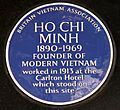Ho Chi Minh facts for kids
Quick facts for kids
Hồ Chí Minh
|
|
|---|---|
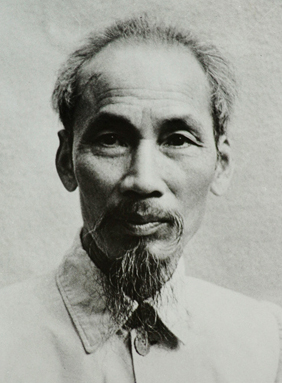
Portrait of Hồ Chí Minh, c. 1946
|
|
| Chairman of the Workers' Party of Vietnam | |
| In office 19 February 1951 – 2 September 1969 |
|
| General Secretary |
|
| Preceded by | Position established |
| Succeeded by | Position abolished |
| First Secretary of the Workers' Party of Vietnam | |
| In office 1 November 1955 – 10 September 1960 |
|
| Preceded by | Trường Chinh |
| Succeeded by | Lê Duẩn |
| 1st President of the Democratic Republic of Vietnam | |
| In office 2 September 1945 – 2 September 1969 |
|
| Preceded by | Bảo Đại (as Emperor) |
| Succeeded by | Tôn Đức Thắng |
| 1st Prime Minister of the Democratic Republic of Vietnam | |
| In office 2 September 1945 – 20 September 1955 |
|
| Preceded by | Trần Trọng Kim (as Prime Minister of the Empire of Vietnam) |
| Succeeded by | Phạm Văn Đồng |
| Minister of Foreign Affairs | |
| In office 28 August 1945 – 2 March 1946 |
|
| Preceded by | Trần Văn Chương (Empire of Vietnam) |
| Succeeded by | Nguyễn Tường Tam |
| In office 3 November 1946 – March 1947 |
|
| Preceded by | Nguyễn Tường Tam |
| Succeeded by | Hoàng Minh Giám |
| Full Member of the 2nd and 3rd Politburo | |
| In office 31 March 1935 – 2 September 1969 |
|
| Personal details | |
| Born |
Nguyễn Sinh Cung
19 May 1890 Kim Liên, French Indochina |
| Died | 2 September 1969 (aged 79) Hanoi, North Vietnam |
| Resting place | Ho Chi Minh Mausoleum, Hanoi |
| Political party | Communist Party of Vietnam (1924–1969) |
| Other political affiliations |
French Section of the Workers' International (1919–1921) French Communist Party (1921–1925) |
| Spouse |
Tăng Tuyết Minh
(m. 1926) |
| Relations |
|
| Parents |
|
| Alma mater | Communist University of the Toilers of the East |
| Occupation |
|
| Signature | |
Hồ Chí Minh/ˌhoʊ tʃiː ˈmɪn/ hoh-_-chee-_-min, 19 May 1890 – 2 September 1969), was a Vietnamese revolutionary and statesman. He served as Prime Minister of Vietnam from 1945 to 1955, and as President of Vietnam from 1945 until his death in 1969.
The details of Hồ Chí Minh's life before he came to power in Vietnam are uncertain. He is known to have used between 50 and 200 pseudonyms. Information on his birth and early life is ambiguous and subject to academic debate. At least four existing official biographies vary on names, dates, places, and other hard facts while unofficial biographies vary even more widely.
Aside from being a politician, Hồ was also a writer, a poet, and a journalist. He wrote several books, articles and poems in Chinese, Vietnamese and French.
Contents
Early life and education
Nguyễn Sinh Cung, later known as Ho Chi Minh, was born in 1890 in the village of Làng Chùa or Hoàng Trù in Central Vietnam. His father, Nguyễn Sinh Sắc, was a scholar and mandarin, while his mother, Hoàng Thị Loan, was a devout Buddhist. Young Nguyễn Sinh Cung received a traditional education, learning about Vietnamese history, culture, and Confucian values. He showed an early aptitude for learning and a strong sense of justice. He was a bright student, excelling in his studies.
His early life wasn't without hardship. He witnessed the struggles of the Vietnamese people under French colonial rule, seeing firsthand the poverty and oppression faced by many. This experience profoundly shaped his worldview and ignited his passion for independence. He saw the unfairness of the system and the suffering it caused.
Discovering the world
In 1911, at the age of 21, Nguyễn Sinh Cung left Vietnam, embarking on a journey that would take him across the globe. He worked in various jobs, including as a cook and a waiter, while traveling to countries like France, the United States, and the Soviet Union. These experiences broadened his horizons, exposing him to different cultures and political ideologies. He learned about different forms of government and the struggles for freedom in other parts of the world. He saw how other nations had achieved independence and how they were governed.
During his travels, he learned several languages, including French, English, and Russian. This linguistic ability proved invaluable in his later political career, allowing him to communicate with people from diverse backgrounds and build alliances. He became a skilled communicator, able to articulate his vision and inspire others.
Path to revolution
Ho Chi Minh's travels weren't just about sightseeing; they were a crucial part of his political education. He became increasingly involved in revolutionary movements, studying various political philosophies and ideologies. He was particularly influenced by socialist and communist ideas, believing they offered a path to social justice and national liberation. He saw how these ideologies could empower the oppressed and create a more equitable society.
He joined the French Socialist Party and became involved in anti-colonial movements. He actively participated in protests and demonstrations, advocating for the rights of colonized peoples. He understood the importance of organization and collaboration in achieving political goals.
Founding the Viet Minh
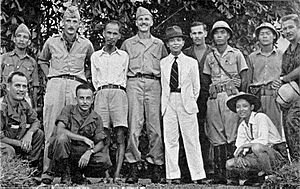
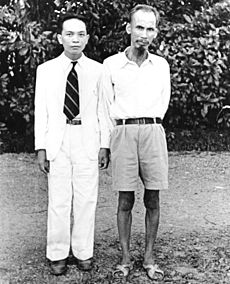
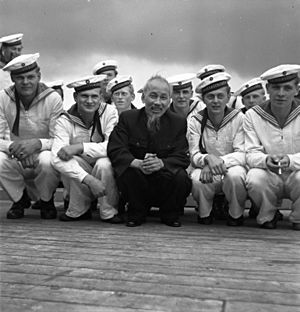
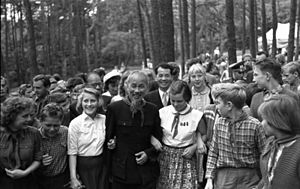
In 1941, Ho Chi Minh returned to Vietnam, determined to lead the fight for independence. He founded the Viet Minh, a broad coalition of nationalist and communist groups, united by the common goal of liberating Vietnam from French colonial rule. The Viet Minh was a diverse group, bringing together people from different backgrounds and political beliefs, all working towards a shared objective.
The Viet Minh's strategy involved a combination of political mobilization and armed struggle. They organized protests, rallies, and other forms of civil disobedience to challenge French authority. They also engaged in guerrilla warfare, using hit-and-run tactics to harass and weaken the French forces. Their strategy was effective in mobilizing the population and wearing down the French military.
Revolution and Proclamation of Independence
In August 1945, taking advantage of the weakening of French power due to World War II, Ho Chi Minh led the August Revolution. This uprising resulted in the overthrow of the Japanese puppet government and the establishment of the Democratic Republic of Vietnam. On September 2, 1945, he proclaimed Vietnam's independence at Ba Dinh Square in Hanoi. This declaration marked a significant turning point in Vietnam's struggle for self-determination.
The proclamation, inspired by the American Declaration of Independence, articulated the Vietnamese people's desire for freedom and self-governance. It resonated deeply with the Vietnamese population, who had long suffered under colonial rule. The proclamation was a powerful symbol of hope and a call to action.
First Indochina War
Following the proclamation of independence, Vietnam faced a new challenge: the return of French colonial forces. This led to the First Indochina War (1946-1954), a protracted conflict that pitted the Viet Minh against the French army. Ho Chi Minh, as the leader of the Viet Minh, played a crucial role in guiding the war effort. He inspired his troops with his unwavering commitment to independence and his strategic brilliance.
The war was a long and arduous struggle, marked by both military victories and setbacks. The Viet Minh, despite being outnumbered and outgunned, employed effective guerrilla tactics and enjoyed widespread popular support. Their resilience and determination were key factors in their eventual success.
Later years
The First Indochina War ended with the Geneva Accords in 1954. These accords divided Vietnam temporarily into North and South Vietnam, with Ho Chi Minh leading the North. The division was a temporary measure, intended to pave the way for reunification through elections. However, these elections never took place, leading to the Vietnam War.
Death
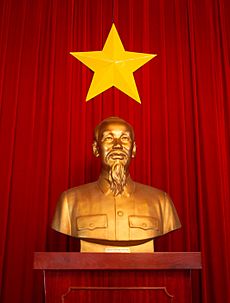
Hồ Chí Minh died of heart failure at his home in Hanoi at 9:47 on the morning of 2 September 1969; he was 79 years old. His embalmed body is currently on display in a mausoleum in Ba Đình Square in Hanoi despite his will which stated that he wanted to be cremated.
Personal life
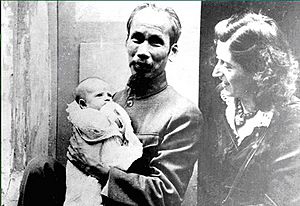
Because he was in exile for nearly 30 years, Hồ could speak fluently as well as read and write professionally in French, English, Russian, Cantonese and Mandarin as well as his mother tongue Vietnamese. In addition, he was reported to speak conversational Esperanto.
Hồ Chí Minh married Zeng Xueming in October 1926. However, the couple lived together for less than a year as Zeng didn't want to engage in the communist movements. In 1927, the mounting repression of Chiang Kai-shek's KMT against the Chinese Communists compelled Hồ to leave for Hong Kong, and his relationship with Zeng appeared to have ended at that time. In addition to the marriage with Zeng Xueming, there is a number of published studies indicating that Hồ had a romantic relationship with Nguyễn Thị Minh Khai.
Recognition
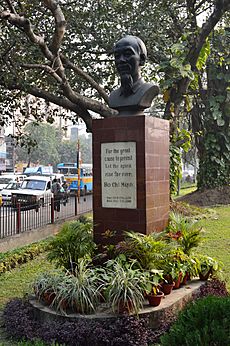
Busts, statues, and memorial plaques and exhibitions are displayed in destinations on his extensive world journey in exile from 1911 to 1941 including France, the United Kingdom, Russia, China, and Thailand.
Various places, boulevards, and squares are named after him around the world, especially in Socialist states and former Communist states. In Russia, there is a Hồ Chí Minh square and monument in Moscow, a Hồ Chí Minh boulevard in Saint Petersburg, and a Hồ Chí Minh square in Ulyanovsk (the birthplace of Vladimir Lenin, a sister city of Vinh, the birthplace of Hồ Chí Minh).
International influence
Hồ Chí Minh is considered one of the most influential leaders in the world. Time magazine listed him in the list of 100 Most Important People of the Twentieth Century (Time 100) in 1998. His thought and revolution inspired many leaders and people on a global scale in Asia, Africa and Latin America during the decolonization movement which occurred after World War II.
Images for kids
-
House on Memorium for Hồ Chí Minh in Ban Nachok, Nakhon Phanom, Thailand
-
Hồ Chí Minh watching a football game in his favorite fashion, with his closest comrade Prime Minister Phạm Văn Đồng seated to Hồ's left (photo right)
-
Hồ Chí Minh Mausoleum, Hanoi.
-
Hồ Chí Minh statue outside Hồ Chí Minh City Hall, Hồ Chí Minh City
See also
 In Spanish: Ho Chi Minh para niños
In Spanish: Ho Chi Minh para niños
- Communism in Vietnam



